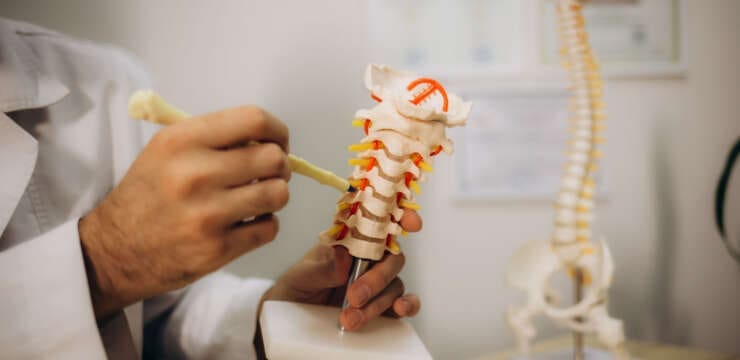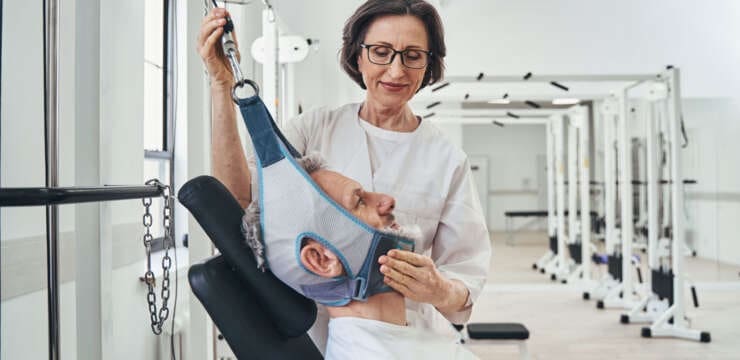Best Exercises and Activities to Improve Posture Naturally | El Paso, TX Health Coach Clinic Good posture is more than just standing tall—it helps your…

Dr. Alex Jmenez, Chiropractor and Health Expert Discusses: Spinal Decompression Therapies, Protocols, Rehabilitation, and Advance Treatments Care Plans
At our offices, we offer conservative care for degenerative spinal conditions, including several treatment modalities. Thus, the traction distinguishes as it can elicit the body’s protective proprioceptive response to distraction, reducing intradiscal pressure and minimizing symptoms secondary to disc herniation and axial pain.
Our integrative treatments aim to determine the clinical effects of a short treatment course of motorized axial spinal decompression for patients with pain and physical impairment caused by either lumbar or cervical degenerative disc pathology with no immediate surgical indication.
Conservative care for mid to long-term degenerative spinal conditions with axial and irradiated pain generally includes pharmacological treatment, physical rehabilitation, or injections. Mechanical traction is an old treatment modality, which has been decreased in use facing other modern technologies or utilized in combination with other treatment modalities, such as manual therapy, exercises, heat, or electrotherapy. We, too, offer advanced spinal treatment workshops and boot camps to help educate patients on the dynamics of spinal hygiene.
Our patients get treated for chronic radicular axial spinal pain. This is a referred pain in the spinal axial skeleton and is considered a syndrome with both nociceptive and neuropathic pain components. Patients report improvement in symptoms with a reduction of the axial load in the spine.
Previous studies have shown a decrease of pressure in the intervertebral disc after traction, unloading of the spinal structure, and alleviating the inflammatory reaction of the nerve roots. Here, we present our patients’ literature and scientific background information to make educated decisions about the advanced spinal decompression protocols.
If you’re looking for a non-surgical solution for your persistent back or leg pain, you may want to try spinal decompression therapy. Unlike invasive or laparoscopic surgeries, spinal decompression does not require the patient to go under the knife. Instead, the patient’s spine is stretched to relieve back and leg pain. The goal of spinal decompression is to create an ideal healing environment for the affected areas.
This treatment is typically used for:
Bulging discs
Degenerating discs
Herniated discs
Call us today to schedule your first appointment! Our team in El Paso is happy to help.

Best Exercises and Activities to Improve Posture Naturally | El Paso, TX Health Coach Clinic Good posture is more than just standing tall—it helps your…

How Telemedicine and Health Coaching Help Manage Sciatica with Integrative Chiropractic Care Sciatica can turn everyday life into a challenge. Sitting at a desk, driving…

Healing Herniated Spinal Discs Naturally: Best Foods High in Protein, Omega-3s, Vitamins, Minerals, and the Power of Water with Chiropractic Care Herniated spinal discs occur…

Uncover the benefits of chiropractic solutions for those struggling with back pain and discomfort from disc herniation & disc bulging. Introduction Many people have to…

Sciatic Nerve Compression, Pinching, and Crush: A Health-Coaching Guide to Healing and Prevention Why this matters When the sciatic nerve (or the lumbar nerve roots…

Headaches After Car Accidents: A HealthCoach Clinic Guide to Lasting Relief Simple, practical steps to understand why headaches linger after a crash—and how an integrated…

Maintaining The Spine: A Guide for Strong, Flexible, Pain-Resistant Backs Definition Spinal health refers to the proper structure, alignment, and function of your spine, enabling…

Teachers, Sciatica, and Chiropractic — A Health-Coaching Playbook for Real-World Relief Why this matters for teachers (and why coaching works) Teaching is physically and mentally…

Restoring Driving Posture via Chiropractic + Functional Medicine at HealthCoach.Clinic Introduction At HealthCoach.At the Clinic in El Paso, the focus is on treating the body…

Integrative Chiropractic & Wellness Coaching: Pathways to Balanced Health and Athletic Vitality Introduction HealthCoach.Clinic is more than a chiropractic office—it’s a place where wellness, functional…

Coaching Sciatic Nerve Health With Chiropractic and Integrative Care Introduction The sciatic nerve is the body’s largest, running from the lower spine through the hips…

El Paso’s Health Coach Clinic: Unlocking Wellness Through Genetics and Functional Medicine Why do some people struggle with stiffness or chronic pain while others bend…

Revive Your Health with El Paso Health Coach Clinic At El Paso, TX Health Coach Clinic – Functional Medicine and Wellness, we are dedicated to…
Holistic Wellness at El Paso, TX Health Coach Clinic: Functional Medicine Excellence Welcome to the El Paso, TX Health Coach Clinic, where we prioritize natural,…

From Impact to Imbalance: The Lasting Effects of MVAs on Posture and Back Health Introduction: The Hidden Cost of Car Accidents Motor vehicle accidents (MVAs)…

Individuals experiencing persistent pain, weakness, numbness, and tingling in the back could be suffering from nerve root encroachment. Could surgery ease nerve compression and improve…

Can using a self-care traction device help and be a cost-effective method of providing cervical relief at home for individuals who have neck pain? Neck…